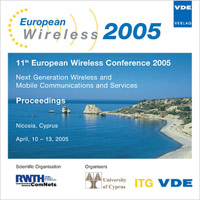Diversity Interference Cancellation for GSM/EDGE using Reduced-Complexity Joint Detection
Conference: European Wireless 2005 - 11th European Wireless Conference 2005 - Next Generation wireless and Mobile Communications and Services
04/10/2006 - 04/13/2005 at Nicosia, Cyprus
Proceedings: European Wireless 2005
Pages: 6Language: englishTyp: PDF
Personal VDE Members are entitled to a 10% discount on this title
Authors:
Nickel, Patrick; Gerstacker, Wolfgang (University of Erlangen–Nuremberg, Institute for Mobile Communications, Germany)
Abstract:
In cellular mobile radio systems, multiple access is causing interference that limits capacity of the networks. The GSM system with multiple users can be interpreted as MIMO system with a desired user and (cochannel and adjacent channel) interferers. Using a multiple–input multiple–output (MIMO) multiuser joint detection approach for desired signal and one or more (strongest) interferers, network capacity can be significantly increased. In this paper, we compare different multiuser detection methods that can be applied to GSM/EDGE (Enhanced Data Rates for GSM Evolution) systems with Gaussian minimum–shift keying (GMSK) modulation in up- and downlink and 8–ary phase–shift keying (8PSK) in the uplink, respectively. Since an optimal solution is not feasible in these applications, joint MIMO reduced–state sequence estimation (RSSE) with adaptive thresholds in metric computations is applied to reduce computational complexity. The M-algorithm is explored as a second method for joint detection with reduced complexity. Algorithms for multiuser detection are compared with interference rejection methods, where interferers are suppressed by filtering. A performance comparison is done by simulations for the GSM/EDGE equalizer test (EQ) and typical urban (TU) channel profiles with known channel impulse responses at the receiver.


